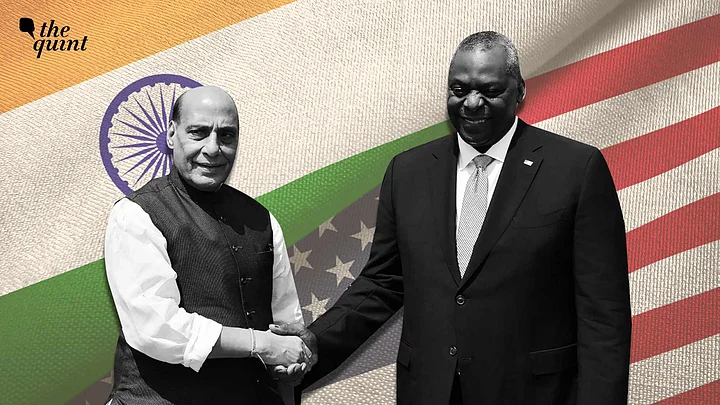US Defence Secretary Lloyd Austin was in India for two days beginning 4 June to discuss ways to further expand the bilateral strategic engagement with India. The visit came ahead of Prime Minister Narendra Modi's trip to Washington two weeks later.
This is General Austin’s second visit to India. His previous trip was in March 2021. The India-US defence and strategic ties have been on an upswing in the last few years.
Following bilateral discussions on 5 June, Defence Minister Rajnath Singh and the US Defence Secretary concluded a roadmap for Indo-US "Defence Industrial Cooperation” which will provide policy guidance on the issues relating to the defence industrial collaboration between the two countries in the coming years.
They also finalised a number of new defence cooperation projects that are set to be unveiled after Mr Modi's talks with US President Joe Biden in Washington. Among these, is the licensed production of the General Electric 414 turbofan engines for India’s Tejas Mk 2 fighter which is under development.
Indo-US Defence Deal
A Defence Ministry statement was silent on the GE 414 issue, but noted that the two ministers "explored ways of building resilient supply chains.” Adding that now both sides “will identify opportunities for co-development of new technologies and co-production of existing and new systems and facilitate increased collaboration between defence start-up ecosystems of the two countries.”
These are likely to be under the rubric of the INDUS-X platform for start-ups and enterprises of both countries to identify collaborations for high-tech innovations within the ambit o the Initiative on Critical and Emerging Technologies (iCET). The INDUS-X which will also be launched during the PM’s visit to Washington is being helmed by the US-India Business Council.
iCET had been announced in May 2022 and its first round of talks took place between NSA Ajit Doval and his American counterpart Jake Sullivan in January this year. Its aim is to elevate and expand bilateral strategic technology partnership and industrial cooperation between the two countries involving governments, businesses, and academic institutions.
The current round of talks between the ministers and officials of the two countries comes after they have signed key defence and security pacts over the last few years, including the Logistics Exchange Memorandum of Agreement (LEMOA) in 2016 that allows their militaries to use each other's bases for repair and replenishment of supplies.
They also signed the COMCASA (Communications Compatibility and Security Agreement) in 2018, which provides for interoperability between the two militaries and the sale of high-end technology from the United States to India.
Space and AI Co-operation
In October 2020, India and the US sealed the BECA (Basic Exchange and Cooperation Agreement) to further boost bilateral defence ties. The pact provides for the sharing of high-end military technology, logistics, and geospatial maps between the two countries.
In their talks on Monday, Austin and Singh also reviewed the ongoing bilateral defence cooperation activities and said they would maintain its momentum. They referred in particular to the recent dialogue focusing on cooperation in the areas of space and AI. On 23 May, the inaugural US-India Advanced Domains Defence Dialogue (AD3) was held in New Delhi with the US represented by Principal Deputy Assistant Secretary of Defence and Space Policy, Vipin Narang, and Michael Horowitz, Director of the Emerging Capabilities Policy Office of the US.
The dialogue which was agreed to in the last 2+2 Ministerial Dialogue in 2022, was aimed at deepening collaboration on "evolving new defence domains with an emphasis on defence space and Artificial Intelligence.”
Among other issues at play currently are India’s plans to purchase 18 MQ-9B Predator armed drones from General Atomics. The US would also like India to consider buying its F-35 or FA18 Super Hornet fighters as well. Some discussions took place during the visit of US Air Force Secretary Frank Kendall during his visit to India in March when he met NSA Ajit Doval and External Affairs Minister S Jaishankar. At the time, Kendall had announced that the US was willing to go for the full transfer of jet engine technology to India.
Kendall had also spoken of the early discussions between the two sides on an Air Information Sharing Agreement whose details have not been revealed, but it is believed that it will involve the sharing of a wide range of data on weather, light plans, and other areas which can enhance aerial operations and situational awareness.
What Can Be Expected of Modi’s US Visit in India’s Defence Sector
At present, the focus is on the license manufacture of the GE-414 turbofan jet engine which will power India’s LCA-Mk2 fighter. Its predecessor, the GE-404 powers the Mk 1 version of the aircraft. In January, the White House said that it had received an application from GE to jointly make engines here in India. The deal for the license manufacture of the GE 414 is now expected to be announced during the Modi visit.
China's aggressive behaviour in the Indo-Pacific region as well as along the Line of Actual Control (LAC) and ways to combat the threat of terrorism also figured in the talks between Singh and Austin.
Austin had arrived in India following his participation at the Shangri La Dialogue in Singapore. The highlight of that event was that he was able to shake hands with his Chinese counterpart Li Shangfu who has refused to formally meet him because he is under a US embargo for arms sales to Russia since 2018.
In his speech to the Shangri La Dialogue, Austin had called for greater communication between the Chinese and American militaries, even as he warned China against "coercion and bullying” of its allies and partners.
(The writer is a Distinguished Fellow, Observer Research Foundation, New Delhi. This is an opinion article and the views expressed above are the author’s own. The Quint neither endorses nor is responsible for them.)
